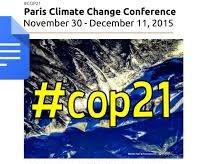Paris Climate Agreement: US has its Way
The apparently smooth approval and adoption on December 12th night of the Paris Agreement to control greenhouse gas (GHG) emissions and the resultant climate crisis was greeted all over the world with huge relief and, in some quarters, with jubilation, a sense that the battle against climate change had been won. After the almost universal disappointment at Copenhagen in December 2009, which was the previous deadline to clinch a deal, followed by the slow progress subsequently through Cancun, Durban etc, and then the dire warnings of the Fifth Assessment Report (AR5) of the Intergovernmental Panel on Climate Change (IPCC), a closure at Paris was certainly anticipated by most experts, commentators and activists. After all, the prospect of failure at Paris was too scary and all national governments were under pressure, both international and domestic, to deliver.
The Paris Agreement certainly represents a breakthrough in the prevailing stalemate in the sense that it binds more than 195 nations to some commonly agreed and binding framework for a joint struggle against climate change with far-reaching measures to combat the crisis. It is the broadest, officially-backed recognition of the reality of human-induced climate change, and the need for a low-carbon pathway to tackle it. It thus signals the beginning of the end of based business as usual based on fossil fuels, and affirms that a transition to renewable energy and environmentally sustainable development is now seriously underway.

Image Courtesy: flickr.com
Yet this success is very limited and masks fundamental deficiencies which bode ill for what is now certain to be an uphill and tough struggle. The self-congratulatory and even triumphalist remarks by many world leaders, delegation heads and even several campaign groups is undeserved, self-serving and based on an exaggerated or deliberately misrepresented sense of achievement. US President Barack Obama proclaimed that the Agreement provides precisely the “enduring framework” required to tackle climate change, and Prime Minister Narendra Modi claimed that the outcome at Paris had “no winners or losers [other than that] climate justice has won.” In fact, the very architecture of the emissions control regime set up in Paris Agreement is structurally flawed, renders the 2 degree goal extremely difficult to achieve if not out of reach, places vast populations especially from developing countries and otherwise vulnerable sections at great risk from climate impacts, and decisively shifts the burden of reducing emissions on to developing countries seriously impairing their ability to overcome poverty, low HDI, poor access to energy, and other major development deficits.
Low Ambition, False Promises
Many claims have been made about the high ambition of the Agreement as regards reducing emissions, specifically in order to counter the widespread impression that efforts have been under par particularly on the part of the US and other developed countries. One of the bracketed options in the earlier drafts of the Agreement, that is aspects on which differing opinions persisted, was whether the goal should be 2 degrees or 1.5 degrees, the latter being pushed for by island states, who rightly view climate change as an existential challenge due to sea-level rise, and many least developed countries and other vulnerable nations. Many such countries had come together at Paris to form a High Ambition Coalition.
One of the big surprises from Paris was the revised goal to reduce global GHG emissions to levels keeping average surface temperature rise to “well below 2 degrees C above pre-industrial levels and pursuing efforts to limit the temperature increase to 1.5 degrees C” (Italics added). The other surprise was that the US, despite its own quantitatively low emission reduction pledge especially in comparison with the EU, joined the High Ambition Coalition and actively persuaded many other developed countries such as the EU and laggard allies such as Australia.
While half a degree Celsius may appear a minor variation, it makes a huge difference in terms of global emissions and their impact on the climate, and prompted the claims to the high ambition of the Agreement. It needs to be understood that, in fact, these goals are misleading, double-edged, and betray questionable motivations of the US.
It is well known that the total of all the intended nationally determined contributions (INDCs) are far below the emission reductions required to meet even the 2 degree C goal, leave alone 1.5 degrees C. In a Synthesis Report on the INDCs released on the eve of the Summit, the UNFCCC Secretariat had concluded that the INDCs would lead to temperature rise of around 3 degrees C. The Agreement text itself “notes with concern that… emission levels… resulting from the INDCs do not fall within least-cost 2˚C scenarios,” and stresses the need to address “this significant gap” of close to 15 Gigatons (Gt) or billion tons. Clearly, the mention of the 1.5 degree goal was mainly meant for dramatic effect and to mobilize support of the Island States and many LDCs who, in effect, were thus broken away from the G-77 grouping and enlisted into the camp of the developed countries led by the US as part of the process of isolating the “emerging” developing countries such as China, India and others and label the latter as responsible for obstructing an ambitious deal.
The Agreement calls for ratcheting-up emission reductions by updating INDCs in 2020 and thereafter in 2025 pursuant to a review, but no effort was made to enhance INDCs at Paris itself. The US and other ICs, who are expected under the UN Framework Convention to lead all efforts to combat climate change, made no effort to amend their INDCs and increase their own level of ambition, despite clear evidence that the extant INDCs were inadequate for the 2 degree goal. Yet they cynically manipulated the sentiments of vulnerable nations with the empty rhetoric of a virtually impossible 1.5 degrees C ceiling which we have almost certainly already breached.
Regrettably, India and other developing countries (DCs) with large, growing economies and hence increasing emissions over the next couple of decades, made no effort to counter these moves by the US. This derives undoubtedly from a long recent history of collusion with the low ambition of the US and its allies, and going along with their drive to create a new framework replace the earlier framework towards low-ambition goals. As a result, the Paris Agreement now contains a built-in tendency to shift the burden on to large developing countries such as India as we shall see in detail below, low ambition in practice, along with contradictory high-sounding prose in the text.
New Framework, Burden on Developing Countries
India’s Environment Minister Prakash Javadekar has triumphantly claimed, including in a Statement to Parliament, that India pushed hard to maintain differentiation between DCs and ICs in the Agreement, and had in fact won this battle since different obligations of developed and developing countries were indeed reflected in mitigation, adaptation, finances and technology, in the Agreement. “Common but differentiated responsibility” (CBDR) is of course the foundational understanding of the UN Framework Convention which ascribes prime responsibility to developed nations for causing the problem, and therefore for tackling it, as per the universally accepted ethical-legal principle of “polluter pays.” That CBDR has been retained, despite all efforts by the US to completely discard it may be right as far as the textual rhetoric goes, but in substance inter-national equity has been given the go-by. In effect, we now have a completely new framework, one long pushed for by the US, replacing the one initially set under the UNFCCC and enshrined under the Kyoto Protocol. Under the new Paris framework, differentiation has been decisively diluted and the emission reduction burden shifted to developing nations. There is also clear evidence in the fine print of the text to indicate that differentiation between developing countries has been introduced in a manner that may acquire a moreformalized form after subsequent review periods, separating those developing countries with high economic growth such as India from the least developed countries and vulnerable nations now emerging as a category on their own,
The import of the new framework in respect of shifting the burden on to developing countries such as India, becomes more clear by looking at carbon budgets and cumulative emissions, explicitly used in the Fifth Assessment Report (AR5) of the Intergovernmental Panel on Climate Change (IPCC), the more accurate metric of emissions in relation to climate change than annual flows.
The atmosphere can hold only a finite amount of carbon dioxide or CO2 (and other GHGs) if temperature rise is to be limited to under 2 degrees C. IPCC/AR5 estimates that, of the roughly 3000 Gt CO2 total budget since the industrial era, about 2000 Gt has already been used up, around 75 percent from the US and other ICs. The remaining budget should have been fairly apportioned between developed and developing countries taking into account their respective historical (i.e. past) emissions. But the US in particular has manipulated the negotiations and the messaging such that historical emissions are completely brushed under the carpet, and only future emissions are projected as the problem. With emissions from developed countries on a downward course having already peaked, and emissions from developing nations such as India necessarily still climbing, this structurally shifts the emission reductions burden on to the latter.
Of the remaining carbon budget of 1000 Gt of carbon dioxide, 750 Gt would have been used up by 2030 by the current INDCs, leaving only a small 250 Gt after that for all countries, both developed and developing! The US and other advanced capitalist countries, by building up their emissions till now, and pledging only modest reductions till 2030, have seen to it that emission reductions by developing nations are far more than those by the ICs, about three times as per previous estimates. This imbalance would only worsen after 2030 when much steeper cuts would be required. If the 1.5 degree goal is to be attained, the remaining budget would be an impossible 500 Gt of CO2!
The US and other ICs have also been allowed to get away with aspirational obligations of providing technology and finances to DCs, with a notional floor of $100 billion from 2020 onwards. All notion of compensation for loss and damage already caused or reparations by developed nations have been tossed clean out the window, although our Environment Minister seems to think otherwise as he stated in Parliament. Contrary to PM Modi’s claims, the US and advanced capitalist countries have emerged a clear winner having maintained their economic dominance and having negated equity, while ceding a few nice phrases in the Agreement. PM Modi also seems to have got it wrong in claiming victory for the cause of social justice which has atually been mentioned in the Paris Agreement only in inverted commas!
Statements from the White House after Paris have now made crystal clear that the shift from the old framework of differentiation based on historical emissions to the new framework focused on future emissions and hence implicitly focusing on the large developing countries such as India has been the result of a clear and systematically executed US strategy at play since Copenhagen. Chalk this victory up to the US!
Incidentally, there is some debate among experts as to how legally binding this Agreement is. It is definitely not a Treaty, mainly because the US had made it very clear that it could not join one since its Congress would never consent to do so, a problem that has plagued the climate negotiations ever since Rio in 1992, and a major reason for the US not joining the Kyoto Protocol. On the other hand, the Paris Agreement is acknowledged to have legal force, albeit with no penal provisions for failure to keep up to obligations, and towards this end enjoins all signatory nations to obtain ratification from appropriate State structures: here the US has stated that approval by its Executive branch i.e. the President would suffice and it does not need to seek or obtain Congressional approval.
Rough Road Ahead for India
In sum, therefore, the Paris Agreement leaves humanity facing a rough road ahead, with developing countries and India in particular, carrying an extremely heavy load. India will not only have to meet its INDC target of reducing emissions intensity of GDP by 33-35 percent below 2005 levels by 2030 under international scrutiny, but will have to keep fighting against continuing and growing pressure to take on even more emission cuts.
India will have to embrace a very different development path with unfamiliar modes of governance in order to achieve the INDC goals, leave alone the transformative pathway that will be required in the long run. It must directly and seriously address the deep and worsening inequality that exists within the country, especially as regards energy access in electricity, cooking fuels, transport, housing and social infrastructure, much as India has been rightly demanding between countries. A galloping personal vehicle industry, bullet trains catering to a minuscule proportion of railway passengers, and laggard mass public transportation will keep adding emissions but only for the benefit of the few. India can ill afford to promote unplanned urbanization and rampant industrialization along with massive deforestation and land use changes. The INDCs will require careful inter-sectoral planning and coordination, as well as huge improvements in capacities and institutional structures across all levels of governance, central, state and local. There is presently little evidence of moves in this direction. Will the future be any different, as has been promised in India’s INDC?
Disclaimer: The views expressed here are the author's personal views, and do not necessarily represent the views of Newsclick"
Get the latest reports & analysis with people's perspective on Protests, movements & deep analytical videos, discussions of the current affairs in your Telegram app. Subscribe to NewsClick's Telegram channel & get Real-Time updates on stories, as they get published on our website.
























